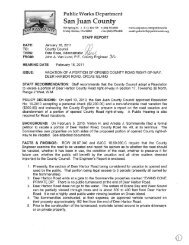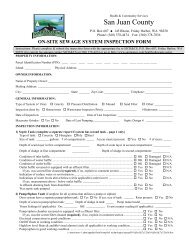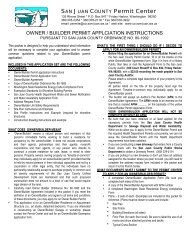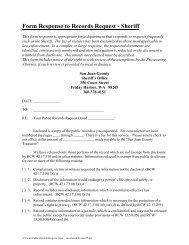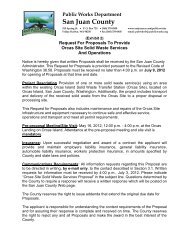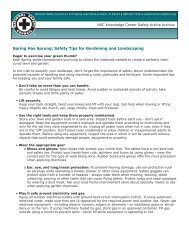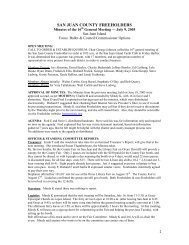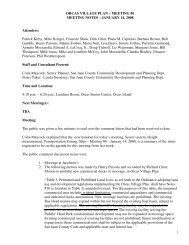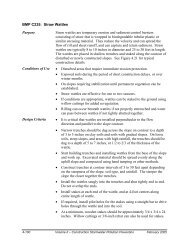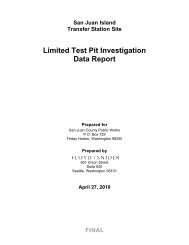Ordinance No._____- 2012 AN ORDINANCE ... - San Juan County
Ordinance No._____- 2012 AN ORDINANCE ... - San Juan County
Ordinance No._____- 2012 AN ORDINANCE ... - San Juan County
You also want an ePaper? Increase the reach of your titles
YUMPU automatically turns print PDFs into web optimized ePapers that Google loves.
Page 25 of 56<br />
Ord. ____-<strong>2012</strong><br />
“Subarea plan” means a detailed plan consistent with but more specific than this code or the Comprehensive<br />
Plan. It may be a detailed land use plan for a specific geographic area, or a functional long-range plan for a land<br />
use or resource issue of <strong>County</strong>-wide concern.<br />
“Subdivision, alteration of” means the alteration of lots or changes in dedications or restrictions or easements<br />
shown on the face of a plat of a subdivision or short subdivision; except as provided by RCW 58.17.040(6) for<br />
boundary line adjustments.<br />
“Subdivision (long)” means a division or redivision of land, normally into five or more parcels, but under special<br />
circumstances for subdivision into two or more parcels, as provided by this code and Chapter 58.17 RCW.<br />
“Subdivision, short” means subdivision of land into no more than four parcels, as provided by this code and<br />
Chapter 58.17 RCW.<br />
“Subdivision, vacation of” means the removal of lots, boundaries, roads, dedications, restrictions, or easements<br />
of a recorded subdivision or short subdivision.<br />
“Substantial alteration” means any alteration, where the total cost of all alterations (including but not limited to<br />
electrical, mechanical, plumbing, and structural changes) for a building or facility within any 12-month period or<br />
single development permit application amounts to 50 percent or more of the value of the building or facility. In<br />
determining the current value of the building or facility, the assessor’s fair market value, or a current appraisal<br />
acceptable to the <strong>County</strong>, may be used.<br />
“Substantial development” means any development of which the total cost, or fair market value, exceeds $2,500<br />
or any development which materially interferes with normal public use of the water or shorelines of the state<br />
(RCW 90.58.030(3)(e)); except that developments meeting the precise terms of the exemptions specified in<br />
WAC 173-27-040 and Chapter 18.50 SJCC (Shoreline Master Program) shall not be considered substantial<br />
developments.<br />
“Substantial improvement” means any maintenance, repair, structural modification, addition or other<br />
improvement of a structure, the cost of which equals or exceeds 50 percent of the market value of the structure<br />
either before the maintenance, repair, modification, or addition is started or before the damage occurred, if the<br />
structure had been damaged and is being restored.<br />
“Subtidal” means the area seaward of the line of extreme low tide.<br />
“Sustainable” means actions or activities which preserve and enhance resources for future generations.<br />
“Swale” means a depressed, vegetated, often wet area of land, or an open drainageway.<br />
“Swamp” means a depressed area flooded most of the year to a depth greater than that of a marsh and<br />
characterized by areas of open water amid soft, wetland masses vegetated with trees and shrubs.<br />
SECTION 9. SJCC 18.20.230, Ord. 10-<strong>2012</strong>, and Ord. 2-1998 Exh. B § 2.3 are each amended to read as<br />
follows:<br />
18.20.230 “W” definitions.<br />
“WAC” means the Washington Administrative Code.<br />
“Warehouse” means a building used primarily for the storage of goods and materials for commercial purposes.<br />
“Water conservation” means a reduction in the amount of water used to carry out a beneficial water use without a<br />
reduction in the value of service the water provides.<br />
“Water-dependent use (or activity)” means any reasonable use which requires a shoreline or over-the-water<br />
location because of its intrinsic nature. Such uses would include but not be limited to aquaculture, docks,<br />
marinas, boat-fueling stations, and marine research installations.<br />
“Water-enjoyment use” means a recreational or other use facilitating public access to the shoreline as a primary<br />
characteristic of the use; a use that provides for recreational use or aesthetic enjoyment of the shoreline for a<br />
substantial number of people as a general character of the use and which through location, design, and operation<br />
assures the public’s ability to enjoy the physical and aesthetic qualities of the shoreline. In order to qualify as a<br />
water-enjoyment use, the use must be open to the general public and the shoreline space of the project must be<br />
N:\L<strong>AN</strong>D USE\LONG R<strong>AN</strong>GE PROJECTS\PCODES-11-0004 CAO FWHCAs\Docs from PC and CC\FWHCAOrdCC_<strong>2012</strong>-10-26.doc



